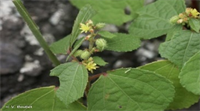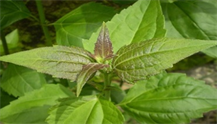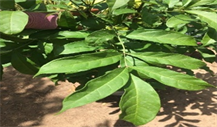Impact of Traditional Oxytocics on the Course of Labour in Maternity Wards in Parakou (Benin) in 2022 ()
1. Introduction
In some parts of the world, specifically in Sub-Saharan Africa and South Asia, deliveries take place without the assistance of health personnel [1] [2] [3] . Inadequate quality and quantity of health personnel, combined with the unregulated and over-the-counter availability of labour-inducing drugs such as oxytocin, have been identified in Pakistan and other countries as contributing to maternal and neonatal mortality [1] [2] [3] . In South Africa, studies by Mabina et al. in 1997 estimated that 43% - 55% of women used traditional oxytocic plants during pregnancy [4] . Olusanya et al., in 2010 in Nigeria, found that 62% of women surveyed had used herbal medicines during pregnancy [5] . In the same vein, Boerma et al. showed that in Kenya and Ghana in 1993, traditional birth attendants provided herbal medicines to women during pregnancy or at delivery for their uterotonic effects [6] [7] . While there may be a beneficial aspect to the use of traditional preparations in the prevention of possible risks to the mother during childbirth in the form of post-partum haemorrhage (PPH), their uterotonic effects can also have adverse consequences, especially if used to induce or accelerate labour. In Malawi and Uganda, studies by Kongnyuy et al. and Mbonye, respectively, suggested that traditional medicines may be involved in a significant proportion of maternal deaths [8] [9] . In Benin, rural women use decoctions and other products during pregnancy for a variety of reasons, including inducing labour, facilitating delivery, and helping expel the placenta. This study was initiated to get an overview of the situation and provide evidence for informed counselling and safer use.
2. Methodology
The study took place in the commune of Parakou (Benin), more precisely in the maternity wards of the various public hospitals and health centres (University Hospital of Borgou-Alibori Departments CHUD/B-A), Military Training Hospital-University Hospital (HIA-CHU) of Parakou, and the Communal health centres of Kpébié, Madina, Zongo, Banikanni, Ganou and Tourou. This was a descriptive and analytical cross-sectional study with prospective data collection on the effect of OPs on the course of labour and delivery in public maternity hospitals in Parakou (Benin) in 2022. The study was conducted over a one-month period from 15 July to 15 August 2022.
The study population was composed of parturients in the public maternity hospitals of Parakou; all parturients were admitted to the various study sites. Parturients who did not give free and informed consent were excluded. This was an exhaustive census of all parturients admitted to the various public maternity hospitals in Parakou during the study period.
The dependent variable was the use of OPs, a binary qualitative variable with yes and no responses collected from the parturient. There were also socio-demographic, economic and cultural variables. The independent variables were environmental, history, possible maternal complications during and after labour, and possible foetal complications during and after labour.
The data were entered twice in EPI Data 3.1fr and then processed with Epi info 7.1.3.3. The characteristics of the qualitative variables were described in terms of proportion with their confidence interval, and those of the quantitative variables in terms of mean with their standard deviation, minimum and maximum. The tables and graphs were produced with EXCEL 2010 software. Pearson’s or Fisher’s chi-square statistical tests were used, depending on the case, for the comparison of proportions. The difference was statistically significant for a p-value of less than 0.05.
This study was submitted to the Local Ethics Committee for Biomedical Research of the University of Parakou (CLERB) of the Faculty of Medicine of the University of Parakou (FM/UP) and ethical approval was obtained. Verbal consent was obtained from the respondents. The confidentiality of the data collected was guaranteed and medical secrecy was respected.
The OPs listed and used by the parturients were as follows (Pictures 1-6).

Picture 1. Hibiscus rosa-sinensis.

Picture 2. Triumfetta cordifolia.

Picture 3. Selaginella lepidophylla.

Picture 4. Hybanthus enneaspermus.

Picture 5. Chromolaena odorata.

Picture 6. Newbouldia leavis.
The use is in several forms (herbal tea, infusion, decoction and maceration or cold infusion) [10] . Oxytocic plants are used by parturients in a variety of ways including oral (most used), rectal, vaginal, topical and nasal. Some are administered simultaneously by two or more routes [11] [12] [13] . These plants contain bioactive substances, in particular indole alkaloids, flavanone-type flavonoids, cyclotides, sterols, polyterpenes and polyphenols, which are thought to be the basis of their oxytocic action [14] [15] [16] .
3. Results
Of the 297 parturients, 109 used oxytocic plants (OPs), i.e. a frequency of use of OPs of 36.7%.
The average age of parturients who used Ops was 27.5 ± 8.9 years with extremes of 17 and 45 years. Figure 1 shows the distribution of parturients by age.
Table 1 shows the distribution of parturients according to their occupation and level of education.
![]()
Figure 1. Distribution of parturients who had recourse to OPs according to age in the public maternity hospitals of Parakou (Benin) in 2022 (N = 109).
![]()
Table 1. Distribution of parturients who used Ops according to their profession and level of education in public maternity hospitals in Parakou (Benin) in 2022 (N = 109).
Of the 109 respondents who used Ops, 12 had a medical and/or surgical history. Medically, these parturients had an antecedent history of diabetes (2; 1.8%), hypertension (1; 0.91%) and asthma (1; 0.91%). Surgically, 7.5% (8/109) had an antecedent history of caesarean section. The parturients who have used OPs were primigravida (29; 26.6%), oligogravida (41; 37.6%), multigravida (23; 21.1%) and large multigravida (16; 14.7%). They were primiparous (49; 44.9%); pauciparous (36; 33.1%); multiparous (14; 12.8%) and large multiparous (10; 9.2%).
The patients (60; 76.3%) who used OPs had an antecedent of OPs use in previous pregnancies. Parturients were in common-law union (59; 54.1%), married (42; 36.6%) and single (8; 7.3%). Of the married women, 80.7% were monogamous and 19.3% were polygamous. They were Muslim (58; 53.2%) and Christian (51; 46.8%). They had an antecedent of diabetes (2; 1.8%), hypertension (1; 0.91%) and asthma (1; 0.91%). The women (8) had a scarred uterus (7.5%). They (62) had performed less than 4 pre-natal consultations (PNCs) (56.9%). The presentation was cephalic in 100% of cases. The oxytocic plants (OPs) used and recorded are shown in Table 2.
The plants were used in different forms, namely bark (21; 14.1%), leaf (96; 90.6%), fruit (3; 2.8%), whole plant (2; 1.9); root (2; 1.9%); stem (1; 0.9%). The plants were used in the form of decoction (97.2%), infusion (17.6%) and maceration (2.4%). The doses were not specified by 93 women (85.3%). One woman (0.9%) specified 500 ml and 15 others (13.8%) specified 250 ml. The routes of administration were oral (107; 99%), rectal (1; 0.9%) and transcutaneous (25; 23.1%). OPs were used in the 1st trimester (1; 0.91%); 2nd trimester (16; 14.7%) and 3rd trimester (92; 84.4%).
The reasons for the use of OPs are shown in Table 3.
Of the 109 pregnant women who used OPs, 35 (32.5%) had had a caesarean section. Of the vaginal deliveries, 25 (23%) had a natural birth, 47 (43.6%) had an assisted delivery and 2 (0.9%) had an assisted delivery by vacuum extraction. The complications recorded were labour dystocia (32; 37.6%) of which 30 (93.8%) were cases of tachysystole, 2 (6.3%) cases of frequency hypokinesia and 2 (6.3%) cases of labour arrest.
![]()
Table 2. Distribution of OPs (scientific names/vernacular names) used by parturients according to different plant families.
![]()
Table 3. Distribution of parturients according to reasons for using OPs in public maternity hospitals in Parakou (Benin) in 2022.
![]()
Table 4. Distribution of parturients who used OPs according to maternal complications during labour in the maternity units of Parakou (Benin) in 2022 (N = 86).
The other anomalies recorded are summarised in Table 4.
No maternal deaths were recorded. Of the 109 neonates, 31 (28.4%) had been transferred to neonatology. Of the 78 non-transferred babies, 72 (92.3%) had a favourable outcome and 6 (7.7%) neonatal deaths. Acute foetal distress was recorded in 11.9% of cases. No foetal deaths were recorded.
The use of OPs by parturients was significantly associated with ethnic groups and background. Indeed, Dendi and relatives (p = 0.031), Fon and relatives (p = 0.007), Yoruba and relatives (p = 0.021) were respectively 1.3, 1.6 and 1.9 times more likely to use OPs than other ethnic groups. Rural parturients were 1.4 times more likely to use OPs. There was no significant association between OPs use and age, occupation, education, religion, marital status, or household type (Table 5).
Table 6 shows the relationship between OPs use and obstetrical history.
The factors associated with OPs use after the multivariate analysis are presented in Table 7.
Parturients’ use of OPs was significantly associated with caesarean delivery (p = 0.001), dynamic dystocia (p = 0.001), Burnout syndrome (p = 0,002), uterine rupture (p = 0.032), rapid labour (p = 0.001), postpartum haemorrhage (p = 0.002), and transfer of their newborn to neonatology (p = 0.002). In fact, these parturients were 1.8 times more likely to give birth by caesarean section, 1.3 times more likely to have dynamic dystocia, 1.1 times more likely to have a uterine rupture, 1.1 times more likely to have a uterine rupture, 1.6 times more likely to have a rapid labour and 1.15 times more likely to have a post-partum haemorrhage.
The use of OPs by parturients was significantly associated with neonatal death (p = 0.021). These newborns were 0.5 times less likely to be transferred to neonatology and 0.19 times less likely to die (Table 8).
There was no association between parturient use of OPs and prolonged labour (p = 0.835), maternal death (0.521) and acute foetal distress (0.412).
There was an association between OPs and the occurrence of complications during labour (p = 0.016). Indeed, the use of the plant Cassytha filiformis of the Lauraceae family and the plant Hybanthus enneaspermus of the Violaceae family had a higher probability than the other plants of having complications during labour (Table 9).
![]()
Table 5. Relationship between OPs use and age, residence, and ethnicity.
![]()
Table 6. Relationship between OPs use and obstetric antecedents.
![]()
Table 7. Factors associated with the use of traditional oxytocic in pregnant women in the city of Parakou.
![]()
Table 8. Relationship between OPs use and caesarean delivery, dynamic dystocia, Burnout syndrome, uterine rupture, rapid labour and postpartum haemorrhage.
PR: prevalence ratio, CI: confidence index.
![]()
Table 9. Relationship between OPs and the occurrence of complications during labour.
4. Discussion
The frequency of OPs use was 36.7%, close to that found by Belinga et al. [17] in 2020 in Cameroun (27%) and lower than those reported by Kongnyuy et al. [5] in 2010 in Nigeria (62%) and Malan et al. [18] in Côte d’Ivoire in 2011 (90.2%). These high frequencies could be explained by the practice of traditional medicine which is an inherent part of culture, history, and personal beliefs. Other authors have reported lower frequencies such as Khang et al. [19] in 2014 in Congo (7.5%), Moussally et al. [20] in 2009 in Canada (9%). This could be explained by the fact that in industrialised countries, the population is much more health-insured and has more recourse to modern medicine.
The average age of parturients was 27.5 ± 8.9 years with extremes of 17 and 45 years. The parturients were essentially young and this finding has been made by other African authors, mainly Foumane et al. [13] in 2021 in Cameroun, Aka et al. [21] in 2016 in Côte d’Ivoire, Nama et al. in Congo in 2014 (25.95 ± 6.79 years) and in 2021 26.22 ± 7.73 years [12] [22] and Belinga et al. [17] in 2020 in Cameroun (24.7 ± 6.9 years).
OPs were used by parturients who were from rural areas (60.5%) and who had secondary education (49.5%). This finding is similar to that made by some authors at respectively 33.33%, 42% for Khang et al. [19] in 2014 in Kipushi, Congo, 69.50% for Nama et al. [22] in Kalemie in Congo in 2021 in 44.0%, and 52.8% for Foumane et al. [13] in 2021 in Cameroun. This discrepancy in results could be explained by the fact that the “schooling of young girls” movement is still in full swing in our environment.
Housewives (32.1%) followed by shopkeepers/sellers (27.5%) were the most represented professional categories among parturients who used OPs. In Congo, similar results were reported by Nama et al. [11] in 2021 in 62% and 20.2% respectively. In contrast, Khang et al. [19] who found a predominance of female farmers (36.67%) in Congo in 2014.
OPs were used by parturients of Muslim religion (53.2%). This finding differs from that of de Foumane et al. [13] in Yaoundé (Cameroun) in 2021, where OPs were used by parturients of Christian religion (95.2%) who had the most recourse to OPs. Concerning ethnicity and the practice of uterotonic pharmacopoeia, it was found that women of Bariba ethnicity and related (30.3%) followed by Fon and related (23.8%) were at the top of the list. This could be explained by the fact that the population of the town of Parakou is made up mainly of the Bariba ethnic group (29.4%) and the Fon ethnic group (18.7%).
Parturients who were in a common-law union (54.1%) were the ones who used OPs. This result does not corroborate with that of Benkhnigue et al. [23] in 2012 in Morocco who reported that OPs were used by married women (80%). In addition, Nama et al. [12] in Mukabe Kasari (Congo) in 2021 and Khang et al. [19] in 2014 in Kipushi (Congo) had drawn the same conclusion as Benkhnigue et al. [23] but with respective proportions of 40% and 95.3%.
OPs were used by parturients who were paucigravida (37.6%) and primiparous (33.0%). Some authors had made the same observation, such as Gilad et al. [24] in Israel in 2017, who reported primiparous women (47.4%). Parturients who used OPs were multiparous according to Belinga et al. [17] in Cameroun in 2020 (52.4%), Nama et al. [11] in Congo in 2021 (65.2%).
In this study, 6 families of OPs were listed. The Violaceae family was the most used (40.7%), followed successively by the Pedalaceae family (35.3%), Bignoniaceae (18.5%), Fabaceae (12.5%), Lauraceae (5.6%), and Selaginellaceae (5.6%). Numerous other studies have identified botanical species and genera used by women in labour for their potential uterotonic action. This was the case of N’Guessan et al. [25] in 2010 in Côte d’Ivoire, who listed 24 families of OPs, three of which (Fabaceae, Bignoniaceae and Lauraceae) were mentioned in this work, i.e. 12.5% of the family common to both studies. Exceptionally, the plant Newbouldia leavis of the Bignoniaceae family was also found during this study. Also, in Côte d’Ivoire (Agboville), N’Guessan et al. [26] in 2009 identified 29 families of OPs, i.e. a rate of 10.34% of common families (Fabaceae, Bignoniaceae, Pedalaceae). Contrary to the non-negligible similarity frequencies found with other authors, we had only 5.26% of OPs families’ common to that revealed by Foumane et al. [13] in Yaoundé (Cameroun) in 2021.
In the practice of utero-stimulating herbal medicine, pregnant women used different parts of plants according to their choice, but leaves (90.6%) and barks (14.1%) were the most used. These results are similar to those of many other authors, including Malan et al. [18] in Côte d’Ivoire in 2011, who found high use of leaves (77.3%) and bark (14.7%) by parturients, Foumane et al. [13] in 2021 in Cameroun with 43% for leaves and 20% for bark and Nama et al. [11] in 2021 in Congo found respective proportions of 35.5% and 30.4%. In Morocco, Benkhnigue et al. [23] in 2012 reported that leaves and stems had equal proportions of 17.89%. Tsivahiny et al. [27] found instead an increased exploitation of leaves (38.9%) and stems (22.2%) in their surveys in Madagascar in 2020. In contrast, in Congo N’Guessan et al. [25] in 2010 concluded that stems and bark were more used with a rate of 45.92%. Nama et al. [22] found a high use of roots (36.7%) in the town of Mukabe (Congo) in 2021. The particular use of leaves compared to other parts of the OPs could be explained by the ease and speed of harvesting, but also by the fact that they are the seat of photosynthesis and sometimes storage of secondary metabolites responsible for the biological properties of the plant.
The parturients used the OPs as a decoction (97.2%), which they administered mainly orally (99%) and in non-specific doses (85.32%). This observation was also made by Tsivahiny et al. [27] in 2020 in Madagascar where OPs were consumed in the form of a decoction by 83.3% and administered orally by 88.9%. In Morocco Benkhnigue et al. [23] in 2010 reported a particularly reduced use of OPs in decoction (26.80%) and without a precise dose (85.12%). These results corroborate those of N’Guessan et al. [25] in Agboville (Côte d’Ivoire) in 2009, who also reported an oral use of OPs (48.97%) in the form of decoction (42.30%). Kouadio et al. [28] in Zanzan (Côte d’Ivoire) in 2016 also found a use of these plants in the form of decoction (36%). On the other hand Adusi-Poku et al. [29] in 2015 in Ghana reported that parturients used OPs in the form of maceration (98.7%). Nama et al. [12] in 2021 in Congo found that plants were administered rectally (82.5%) at the dose of an irrigator (64%). The divergence observed in the modes of preparation, administration and dosages could be due to the difference in plants, cultures and especially the habits of each people.
Parturients reported starting to take oxytocic plants to facilitate their delivery (99.1%) from the third trimester of pregnancy (84.41%). This result is confirmed to a few percentages by those of Foumane et al. [13] 2021 in Cameroun. These authors reported that facilitating childbirth (59%) and accelerating contractions (18%) were the main reasons why parturients took OPs, particularly in the third trimester of pregnancy (65%). The reasons for using OPs according to Nama et al. [11] in Congo in 2021 were that parturients were more motivated by reasons such as opening the cervix (31.5%) and accelerating contractions (24.5%). As regards the period of administration of the plants, they did so in the 3rd trimester of pregnancy.
Parturients who used OPs had dynamic dystocia (37.6%), Burnout syndrome (13%) and uterine rupture (3.5%) during labour. Our results are comparable to those of Aka et al. [21] in Yopougon (Ivory Coast) in 2016 (14.28%). Belinga et al. [17] in Cameroun in 2020 and Lamadah et al. [30] in Egypt in 2014 reported the occurrence of dynamic dystocia in 11.7% and 12% of cases respectively. Uterine rupture was recorded by Neri et al. [31] in Italy in 2017 (2.5%) and by Nama et al. [11] in Congo in 2021 (0.3%). Labour was rapid in 56.5% of parturients who used OPs. Aka et al. [21] also found rapid deliveries in their study in Côte d’Ivoire in 2016 at a rate of 58%. Caesarean section was performed in 32.5% of parturients who used OPs. Aka et al. [21] in Côte d’Ivoire in 2016 also found caesarean deliveries among pregnant women who used OPs, but with a high rate of 68.57%. Belinga et al. [17] in Cameroun in 2020, Gilad et al. [24] in Israel in 2017 and DeMaria et al. [32] in the United States of America in 2018 also found the same, but at low rates of 11.2%, 16.2% and 9.2% respectively.
The complications recorded included postpartum haemorrhage (22.4%). Many authors had recorded this complication but at lower percentages including Belinga et al. [17] in Cameroun in 2020 (2.9%), Gilad et al. [24] in Israel in 2017 (5.4%) and Lamadah et al. [30] in Egypt in 2014 (2%). This difference in proportions could be due to the size of the study population, which is larger in our case.
No maternal deaths were recorded among the parturients who used OPs in the study. Other authors had made the same observation, including Aka et al. [21] in Côte d’Ivoire in 2016, Belinga et al. [17] in Cameroun in 2020 and DeMaria et al. [32] in the United States of America in 2018, who had recorded zero maternal death. In contrast to Nama et al. [11] in Congo in 2021, who reported 0.28% deaths. The lack of qualified health workers and adequate medical facilities could explain these deaths.
Acute foetal distress (11.9%) was one of the foetal complications recorded. This complication is also reported by Lamadah et al. [30] in Egypt in 2014 (16%) and by Gilad et al. [24] in Israel in 2017 (21.6%). Indeed, these authors had a larger study population, which could explain this difference in proportion. The newborns (28.4%) had been transferred to neonatology. This result differs in percentage terms from that of Aka et al. [21] in Côte d’Ivoire in 2016, Belinga et al. [17] in Cameroun in 2020 and Neri et al. [31] in Italy in 2017. These authors, like us, had recorded cases of transfer of newborns to neonatology, but in low proportions of 14.2%, 4.6% and 2.5% respectively. No foetal deaths were recorded, but 7.7% of neonatal deaths were noted. The same observation was made by Aka et al. [21] in Côte d’Ivoire in 2016, who recorded neonatal deaths (4.8%) and zero foetal deaths, and by Belinga et al. [17] in Cameroun in 2020, who reported 3.3% neonatal deaths and no foetal death.
The Fon and related ethnic groups (p = 0.014 and OR = 1.8 [1.18 - 2.72]) and Yoruba and related (p = 0.031 and OR = 2.1 [1.16 - 4.52]) were associated with use of OPs. Indeed, these ethnic groups represent most of the population in the survey area, which is the city of Parakou. Coming from a rural area was associated with the use of OPs (p = 0.036 and OR = 1.4 [1.03 - 1.88]). This finding was made by Tsivahiny et al. [27] in Madagascar in 2020, in which women from rural areas were the ones who used OPs the most (p < 0.001). The rural environment is distinguished from the urban environment mainly by its biodiversity of OPs, and women from this environment would have easier access to these plants. The obstetrical history of multiparity (p = 0.045 and OR = 1.2 [1.04 - 3.40]) was associated with the use of OPs. This finding is similar to that of Tsivahiny et al. [27] , who reported that multiparous females (p = 0.003) were the ones who used OPs the most. In fact, multiparous women had a certain experience of maternity compared to primiparous women, and they constitute this generation which would have directly acquired the practice of uterotonic phytotherapy considered as a cultural heritage. The use of OPs was significantly associated with a risk of giving birth by caesarean section (p = 0.001 and OR = 1.8 [1.23 - 2.65]). Aka et al. [21] in Côte d’Ivoire in 2016 made the same finding, reporting that there was a higher risk of caesarean delivery (p < 0.0001) in parturients who used OPs. In addition, Lamadah et al. [30] in Egypt in 2014 reported a risk for parturients who used OPs to deliver by caesarean section (p = 0.002). In contrast, Gilad et al. [24] in Israel in 2017 and Neri et al. [31] in Italy in 2017 did not find a relationship between OPs and caesarean delivery. The use of OPs was significantly associated with a risk of dynamic dystocia during labour (p = 0.001 and OR = 1.3 [1.12 - 1.49]). This finding is comparable to that of Aka et al. [21] in Côte d’Ivoire in 2016, who reported that the use of OPs tripled the risk of dynamic dystocia during labour (p < 0.001 and OR = 3.21 [1.37 - 5.05]). OPs, like synthetic oxytocin, can induce dynamic dystocia, especially when dosages are not respected.
The use of OPs was significantly associated with a risk of developing pre-uterine rupture syndrome (p = 0.002 and OR = 1.1 [1.02 - 1.17]) and uterine rupture (p = 0.032 and OR = 1.1 [0.97 - 1.17]). Aka et al. [21] in Côte d’Ivoire in 2016 reported a risk of Burnout syndrome in parturients who used OP (p = 0.0015). In contrast, Neri et al. in Italy in 2017 found no significant relationship between the use of OPs and the occurrence of uterine rupture [31] .
The use of OPs was significantly associated with an elevated risk of postpartum haemorrhage (p = 0.002 and OR = 1.15 [1.05 - 1.27]). This finding does not corroborate that of Gilad et al. in Israel in 2017, who found no significant association (p = 0.457) [24] . This was also the case for Neri et al. in Italy in 2017 [31] . The use of OPs by parturients was significantly associated with a lower risk of neonatal transfer (p = 0.002 and OR = 0.50 [0.31 - 0.79]). Indeed, these newborns were less likely to be transferred to neonatology. Neri et al. [31] in Italy in 2017 reported no significant association between the use of OPs by parturients and the transfer of their newborn to neonatology.
The use of OPs was significantly associated with a lower risk of neonatal death (p = 0.021 and OR = 0.19 [0.03 - 0.94]). This result is not consistent with that of Aka et al. [21] in Côte d’Ivoire in 2016, who found no significant association between parturient use of OPs and neonatal death. The sample size and the use of OPs at non-specific doses by parturients could explain this difference.
5. Limitations of the Study
The sensitivity of the use of OPs means that patients may have reservations about the correct answer given that the use of these herbs is not officially authorised by science, with the feeling that they are being judged by the health staff.
6. Conclusion
The use of OPs is a common practice, and the factors associated with the use of OPs are multiple. The practice was correlated with a number of risks to the mother during labour. However, it was found that the use of OPs by parturients reduced the risk of their newborns being transferred to neonatology and dying at birth. The active principles of these plants are not really known, hence, the interest in a phytochemical analysis is in order to identify them, measure them and propose a better use.